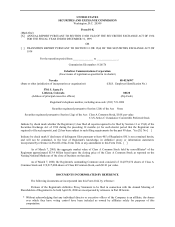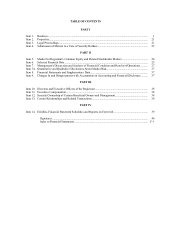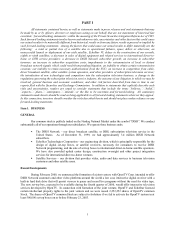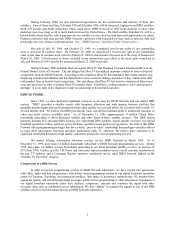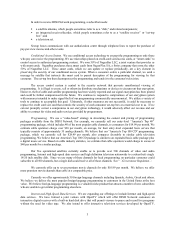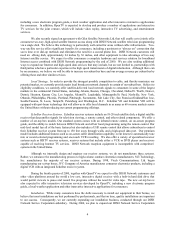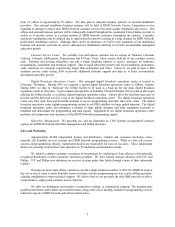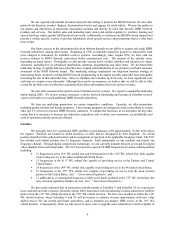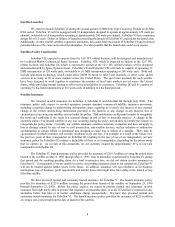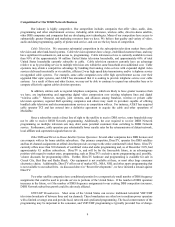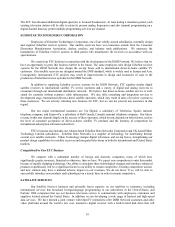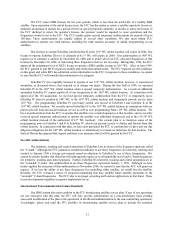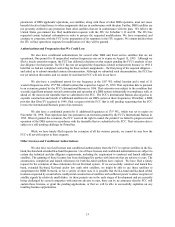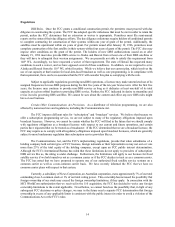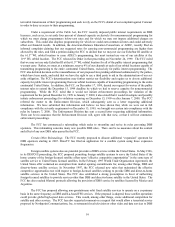Dish Network 1999 Annual Report Download - page 9
Download and view the complete annual report
Please find page 9 of the 1999 Dish Network annual report below. You can navigate through the pages in the report by either clicking on the pages listed below, or by using the keyword search tool below to find specific information within the annual report.7
receiving signals from both the 110° WL and119° WL orbital locations, these costs are not expected to be as
significant during 2000 as previously planned.
EchoStar I and EchoStar II each have 16 transponders that operate at 130 watts of power. Subject to the
anomalies described below, EchoStar III and EchoStar IV each have 32 transponders that operate at approximately
120 watts per channel, switchable to 16 transponders operating at over 230 watts per channel. EchoStar V has 32
transponders that operate at approximately 110 watts per channel, switchable to 16 transponders operating at
approximately 220 watts per channel. Each transponder can transmit multiple digital video, audio and data channels.
Each of our satellites has a minimum design life of 12 years.
During 1998, three transponders on EchoStar III malfunctioned, resulting in the failure of a total of six
transponders on the satellite. While the satellite can operate a maximum of 32 transponders at any time, the satellite
manufacturer equipped it with a total of 44 transponders to provide redundancy. As a result of this redundancy and
because the FCC licensed us to operate only 11 transponders at 61.5° WL, where the satellite is located, the transponder
anomaly has not caused a loss of service to date. The satellite manufacturer, Lockheed Martin, has advised us that it
believes it has identified the root cause of the failures, and that while further transponder failures are possible,
Lockheed Martin does not believe it is likely that the operational capacity of EchoStar III will be reduced below 32
transponders. Lockheed Martin also believes it is unlikely that we would lose the ability to operate at least the 11
licensed transponders on the satellite.
As a result of the failure of EchoStar IV solar arrays to fully deploy, and the unrelated failure of 20
transponders to date, a maximum of approximately 16 of the 44 transponders on EchoStar IV are currently available for
use. Due to the normal degradation of the solar arrays, the number of available transponders may further decrease over
time. Based on current data from Lockheed Martin, we expect that at least 10 high power transponders or 5 extra-high
power transponders will probably be available over the remaining useful life of the satellite, absent significant
additional transponder problems or other failures. In addition to the transponder failures, EchoStar IV has experienced
anomalies affecting its heating systems and fuel system during 1999. As a result of the heating system and fuel system
anomalies, the remaining useful life of EchoStar IV has been reduced to less than 10 years.
In September 1998, we filed a $219.3 million insurance claim for a constructive total loss under the launch
insurance policy related to EchoStar IV. However, if we receive $219.3 million for a constructive total loss on the
satellite, the insurers would obtain the sole right to the benefits of salvage from EchoStar IV under the terms of the
launch insurance policy. Although we believe we have suffered a total loss of EchoStar IV under that definition in the
launch insurance policy, we intend to negotiate a settlement with the insurers to compensate us for the reduced satellite
transmission capacity and allow us to retain title to the asset.
While there can be no assurance, we do not currently expect a material adverse impact on short or medium
term satellite operations. Although we have not fully assessed the impairment to EchoStar IV from the transponder
failures and other anomalies, we continue to believe that insurance proceeds will be sufficient to offset all write-downs
of satellite assets that might ultimately be necessary because of lost functionality. However, we can provide no
assurance that additional material failures will not occur, and we can provide no assurance as to the ultimate amount
that may be received from the insurance claim, or that coverage will be available. We will continue to evaluate the
performance of EchoStar IV and may modify our loss assessment as new events or circumstances develop.
Our satellite insurance policy for EchoStar IV consists of separate identical policies with different carriers for
varying amounts which, in combination, create a total insured amount of $219.3 million. Two of the participants in our
insurance line have notified us they believe that our alleged delay in providing required insurance claim information
may reduce their obligation to pay any settlement related to the claim. One carrier recently asserted it has no obligation
to pay. We strongly disagree with the position taken by those insurers and continue to believe that the EchoStar IV
insurance claim will be resolved in a manner satisfactory to us. However, we cannot assure you that we will receive
the amount claimed or, if we do, that we will retain title to EchoStar IV with its reduced capacity. We met with our
insurance carriers in November 1999 and are continuing discussions to resolve our claim.

